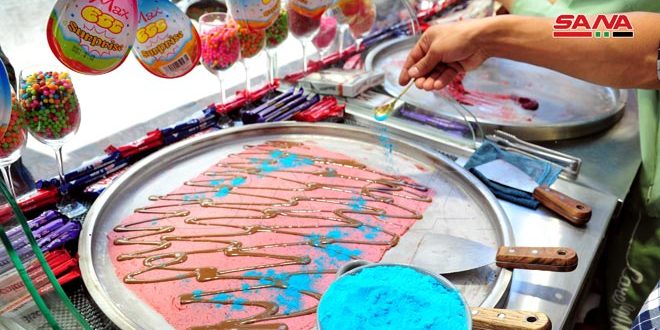Ice cream “on the saj” is a new type of ice cream that has recently increased in popularity in some ice cream shops in Damascus, occupying a special place alongside the Arabic ice cream known as “Daq ice cream” as the Syrians call it.
In Al-Qamariya neighborhood of Damascus, there are today, about six shops offering this new type of ice cream. They attract passersby with the sound of their tools while stirring and pounding the materials on the saj, in addition to the bright colors of the ingredients that are mixed with it, so that these shops began to spread in several other areas in Damascus and a number of governorates.
The manufacturing method of “ice cream on saj” is of Thai origins and has spread significantly in recent years in some Arab countries until it found its way into Syria three years ago, according to Maher Al-Daoud, one of the workers in this field.
He indicated that this type of ice cream needs simple tools, a metal sheet ” saj” that is cooled to a temperature of 50 degrees below zero, by sticking cooling pipes below it. Then the ingredients are placed on the saj, where they are knocked and cut with a graceful movement by the hands of the worker using metal spoons while he spreads the liquid mixture “consisting of milk, cream, and vanilla with the juice of one of the natural fruits. After that, he mixes up the mixture well and then cuts it and shapes it into rolls to be served in plates of biscuits or “small cartons” after decorating it with cream and nuts.
Al-Daoud and his 12 colleagues began working to realize this idea after watching a number of videos that spread from several countries describing how it was made.
Thus, they began their search for all matters related to the manufacture of this type of ice cream, as their idea turned into a small project that now constitutes a main source of livelihood for them. The high turnout of people to their shop encouraged them to create new ideas to add while making ice cream or when preparing it, as they said, pointing to some of the difficulties they sometimes face in securing the necessary raw materials, especially nuts, in addition to the power outage.
Gathering in front of ice cream shops to watch how it is made, is a must-see scene in front of every store because it is something new to the Syrian market, according to Mrs. Elham Ibrahim, who added: “My children heard from their friends about ice cream on saj and they insisted that we should go see it and buy it… It tastes like it looks, very nice.”
Elissar Muhammad expresses her admiration for the way this type of ice cream is made, indicating that she and her friends intended to go to buy it after watching many videos about it on Facebook and YouTube.
However, despite the innovation and diversity that the ice cream industry is witnessing, the status of Arabic ice cream is still at the top of the desires of many Syrians, who sometimes describe its flavor as “heritage,” especially since some of the shops that manufacture them in Damascus have become a tourist destination to eat the Arabic ice cream.
Ahmed Bekdash, owner of the Bekdash shop in the Al-Hamidiya market, said, “We have been working in the Arabic ice cream industry for more than a hundred years, as my grandfather started working in it in 1895 AD with primitive simple methods. We inherited this work from him and my father and continued to work striving to improve and develop the product and the tools without violating the heritage features that have become a beacon in the place and a tourist landmark for many.”
The Arab ice cream industry is going through several stages and experience plays a key role in its manufacture. Bekdash indicated that the milk is placed in tanks for cooling, sterilization, and filtering, to be boiled later, adding sugar, sahlab, and vanilla in specific quantities.
The preparation process ends when the material resulting from mixing and boiling, called liquid ice cream, is cooled and left to ferment and becomes ready for the process of drawing and pounding in order to empty it from the air. Then the cream and nuts such as pistachios are added to it to be cut into specific shapes.
“Despite the difficulties we face, we are continuing with this work, which has become a family heritage for more than a hundred years, as well as the heritage of Syria, which is known for its deep-rooted civilization. In addition, it contributes to employing more than 40 permanent and seasonal workers, which benefits them and their families”, Bekdash concluded.
Amal Farhat

